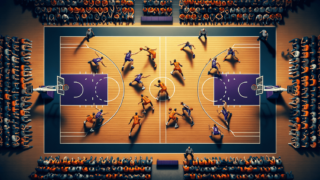
Are you ready to unlock the secrets of one of basketball’s most popular and strategic defensive schemes? Welcome to our deep dive into the 2-3 zone defense! In this blog post, we’ll explore every nook and cranny of this dynamic formation, perfect for both beginners and veteran hoop-heads alike. Learn the ins and outs of how the 2-3 zone defense works, its strengths and weaknesses, and why it continues to be a go-to strategy for many elite basketball coaches. So, let’s lace up our sneakers, hit the hardwood, and make that swishing sound as we start our journey into the fascinating world of 2-3 zone defense.
What’s a 2-3 Zone Defense in Basketball?
A 2-3 zone defense in basketball is a strategic defensive scheme where five players are positioned in two lines – two players in the front line near the wings or elbows, and three players in the back line situated near the baseline. The main goal is to cover specific areas or zones on the court, rather than defending one-on-one against the offensive players. This type of defense relies on quick rotations, communication, and strong team play to disrupt the opponent’s offensive flow by contesting shots, preventing easy baskets, and forcing turnovers.
Understanding the 2-3 Zone Defense Fundamentals
The 2-3 zone defense in basketball revolves around the idea of players being responsible for designated areas or zones on the court, as opposed to purely matching up with individual offensive players. Before jumping into its intricacies, let’s start with understanding the core fundamentals of the 2-3 zone defense as a whole. This will provide a strong foundation to build upon as you learn more advanced strategies later on.
Positioning and Responsibilities
In a typical 2-3 zone, the five defenders are arranged in two lines. The front line, consisting of two players, is usually occupied by the guards. They can be found near the wings or elbows, while the back line consists of three players, typically two forwards and the center, who cover areas closer to the baseline. Here are the primary responsibilities for each position:
- Front Line Guards: Close out on perimeter shooters, apply ball pressure, and prevent straight-line drives.
- Wing Forwards: Contest mid-range jump shots, protect the baseline, provide help-side defense, and challenge low-post players.
- Center: Anchor the paint, block shots, provide help-side defense, and secure defensive rebounds.
Communication and Rotation
Effective communication among teammates is crucial to the success of the 2-3 zone defense. Defenders must constantly exchange information on the court about the whereabouts of offensive players, ball movement, and potential threats. This enables each player to know when to rotate or switch zones, providing optimal defensive coverage while minimizing open gaps for the offense to exploit.
Quick and efficient rotations are vital for a successful 2-3 zone defense. Defenders need to be agile and alert, shifting responsibilities based on the movement of the ball and the offensive players. Proper rotations essentially create a swarming effect, making it difficult for the offense to find open shots or penetrate the paint.
The Advantages of the 2-3 Zone Defense
When executed correctly, the 2-3 zone defense can offer several advantages to a basketball team. These benefits include:
Disrupting Offensive Rhythm
One of the fundamental goals of the 2-3 zone is to disrupt the opponent’s offensive flow. By forcing the offense to navigate through a complex web of defenders, this can make it difficult for them to establish a consistent rhythm or find easy scoring opportunities. Opposing teams often have to adjust their usual offensive tactics to counter the 2-3 zone, which can take them out of their comfort zone and lead to inefficiency.
Protecting the Paint
With a packed paint area and multiple defenders ready to collapse on any interior threat, the 2-3 zone defense can effectively limit an opponent’s ability to score inside. This can be particularly beneficial against teams that boast dominant low-post players or those that rely heavily on penetrating guards to generate their offense.
Conservation of Energy
Being a zone-based system, the 2-3 defense can reduce the physical demands of defending in man-to-man situations. This is especially crucial for teams with a thin roster or players prone to fatigue or fouling. By focusing on guarding regions rather than chasing individual players, the 2-3 zone can help conserve your team’s energy for critical stretches of the game.
Creating Turnovers
The 2-3 zone defense can also generate turnovers, leading to easy fast-break opportunities. By trapping and pressuring ball handlers and utilizing quick rotations to intercept passes, defenders can force bad decisions and turnovers from the offense. Taking advantage of these miscues can help generate points in transition, which can swing momentum in your favor.
The Drawbacks of the 2-3 Zone Defense
Despite its potential benefits, the 2-3 zone defense also comes with some inherent weaknesses. Opponents may exploit these vulnerabilities if your team is not well-prepared or if individuals fail to execute their responsibilities effectively. The main drawbacks include:
Vulnerability to Outside Shooting
Given the focus on protecting the paint, the 2-3 zone can sometimes leave outside shooters with open looks, especially in areas such as the corners. Teams with knock-down shooters can punish a 2-3 defense by spacing the floor and making them pay from beyond the arc. This vulnerability becomes even more pronounced in the era of pace-and-space basketball, where long-distance shooting is highly valuable.
Rebounding Difficulties
One of the most significant disadvantages of the 2-3 zone defense lies in securing defensive rebounds. Since players are responsible for specific areas rather than individual matchups, finding and blocking out offensive players for rebounds can be more challenging. This can lead to offensive rebounds and second-chance points for the opposing team, diminishing the effectiveness of your defense.
Potential for Overload
Experienced offenses can exploit the 2-3 zone by overloading one side of the court. By putting more offensive players in a specific area, it can stretch the defense and generate open scoring opportunities either inside or outside. To counter this, your team must communicate and adjust quickly to maintain defensive integrity.
Advanced 2-3 Zone Defense Tactics
While the 2-3 zone defense inherently offers vital advantages, implementing advanced tactics can make it even more effective. Here are a few such strategies:
Trapping and Doubling
Occasionally trapping or doubling an offensive player, especially the ball-handler, can lead to rushed decisions and turnovers. By having two defenders aggressively collapse onto the offensive player, it increases the likelihood of a bad pass, traveling violation, or even a potential steal. Timing and surprise are the keys to successfully double or trap during a 2-3 zone defense.
Defensive Slides and Closeouts
While the 2-3 zone allows for some conservation of energy, defenders should still work diligently to cover ground and contest shots. Players must implement effective defensive slides and closeouts to eliminate open shots and deter offensive penetration. Remember, the objective is to make every shot attempt as difficult as possible for the opponent!
Disguising Defensive Formations
Experienced offensive players and coaches often recognize a zone defense from the onset. However, disguising the 2-3 zone as a man-to-man initially can confuse the offense and create a brief moment of hesitation. This requires defenders to start in a man-to-man setup and then seamlessly transition to their zone responsibilities once the possession starts.
Enhancing Your 2-3 Zone Defense through Drills and Preparation
Executing an effective 2-3 zone defense in basketball demands practice and preparation. Here are some drills and preparation techniques to help your team master this defensive system:
The Shell Drill
The shell drill is a staple in basketball coaching and is highly effective for teaching fundamentals, rotations, and communication in the 2-3 zone defense. Players work on their positioning, closeouts, help-side defense, and rotations in a controlled environment with specific scenarios dictated by the coach. Variations of the shell drill can help improve defensive switches, trapping, and rebounding responsibilities.
Zone Slides
Practice zone slides as a team to help players better understand rotations and coverage within the 2-3 zone defense. Players start in their respective defensive positions and slide or sprint to their next spots in response to ball movement. This drill should be repeated multiple times to develop muscle memory and familiarity with various offensive scenarios.
Defensive Breakdown Drills
Breakdown drills are essential for honing specific skills and responsibilities within the 2-3 zone defense. For example, having two guards pressure the ball-handler and force them to make a pass can reinforce the principles of trapping and doubling. Meanwhile, forwards can practice their help-side responsibilities by closing out and contesting shots from the low-post or the wings.
By investing time and effort into understanding and practicing the 2-3 zone defense, your basketball team can take advantage of its many benefits while mitigating its potential drawbacks. Remember, effective communication, quick rotations, and diligent preparation are the keys to mastering this popular defensive scheme!
Breaking Down Opponent’s 2-3 Zone Defense
Learning how to break down an opponent’s 2-3 zone defense is essential for any basketball team that wants to succeed against this strategic formation. In this section, we will explore some effective offensive tactics to counter and exploit a 2-3 zone defense.
Ball Movement and Spacing
One of the primary ways to attack a 2-3 zone is to focus on quick and accurate ball movement. When the basketball is passed swiftly from one player to another, it forces the defense to constantly rotate and adjust. This can create mismatches, gaps, and open shots within the zone. Proper floor spacing is essential to maximize the effectiveness of ball movement, as offensive players should be spread out and ready to catch and shoot or drive into any open lanes.
Utilizing the High Post and Short Corners
The high post area, near the free-throw line, and the short corners, closer to the baseline, are vulnerable spots within a 2-3 zone defense. By placing an offensive player in the high post, the defense has to decide between collapsing in the paint or stepping up to contest the shot. Similarly, the short corners often demand the forwards on the back line to make decisions about their defensive responsibilities. When in these areas, the offense can exploit passing lanes, find open shooters, or create scoring opportunities through quick decision-making and execution.
Offensive Rebounding
As mentioned earlier, one of the weaknesses of the 2-3 zone defense is securing defensive rebounds. The offense should use this to their advantage by relentlessly crashing the boards and seeking second-chance points. By aggressively pursuing offensive rebounds, the team can help compensate for any missed shots created by the zone defense and generate additional scoring opportunities.
Screening the Zone
Although screens are typically associated with man-to-man offenses, setting screens against a zone defense can still be highly effective. Offensive players can set screens on defenders to free up teammates for open shots, or to impede defensive rotations. Screens that target key defenders can create confusion or miscommunication within the zone, leading to open shots or lanes for drives.
2-3 Zone Variations and Adjustments
While the classic 2-3 zone defense has proven to be a popular and effective choice for many teams, coaches and players can also experiment with modifications or adjustments to tailor the defense to their specific needs and matchups. Here are a few variations you might consider:
Matchup Zone Defense
A matchup zone defense is a hybrid system that combines elements of both zone and man-to-man defenses. Each defender still has responsibility for a specific area, but they also pick up and guard an offensive player who enters their zone more aggressively, as if they were in man-to-man defense. This can make it more challenging for the offense to identify the defensive scheme and adapt appropriately.
Extended 2-3 Zone Defense
In an extended 2-3 zone defense, the front line guards apply more pressure on the ball-handler and push further out toward the perimeter. The objective is to disrupt the flow of the offense with increased ball pressure, while the back line defenders maintain the integrity of the zone and deter penetration. This can be an effective adjustment against teams with strong guard play or noteworthy perimeter shooters.
Box and One Defense
The box and one defense is another hybrid defensive scheme that can be employed alongside a 2-3 zone defense. In this setup, four defenders play in a box shape (two up front and two in the back) while one designated player guards the opponent’s best scorer in a strict man-to-man fashion. This can be especially helpful when facing a team with a single dominant player who demands extra defensive attention.
By understanding the various ways to counter, adjust, and modify the 2-3 zone defense, your basketball team can develop a comprehensive understanding of this strategic formation and maximize its advantages on the court!
FAQ Section: 2-3 Zone Defense in Basketball
Here are some frequently asked questions and answers regarding the 2-3 zone defense in basketball. These FAQs will help those interested in exploring this defensive scheme, providing a quick reference to common queries and concerns.
1. Who should play each position in a 2-3 zone defense?
Traditionally, guards occupy the front line in the 2-3 zone defense while forwards and the center occupy the back line. Guards should be quick, agile, and have strong perimeter defensive skills, while forwards and centers should possess strong interior defensive abilities, good rebounding fundamentals, and the ability to block or alter shots.
2. How does a 2-3 zone defense compare to other zone defenses, like the 1-3-1 or 3-2?
Each zone defense has its unique strengths and weaknesses. The 2-3 zone focuses on packing the paint and interior defense, while the 1-3-1 aims to trap and disrupt the offense on the wings and corners. The 3-2 zone emphasizes perimeter defense and can be more effective against teams with strong outside shooters.
3. Can a 2-3 zone defense work at all levels of basketball?
Yes, the 2-3 zone defense can be effective at all levels of basketball, from youth leagues to professional organizations, as long as it’s executed properly with strong communication, proper rotations, and diligent preparation.
4. What is the key to success in 2-3 zone defense?
Effective communication among defenders, strong rotations, and diligent preparation are essential to the success of the 2-3 zone defense. Players must work together seamlessly to cover areas of the court while minimizing open gaps for the offense to exploit.
5. Can the 2-3 zone defense be vulnerable to outside shooting?
Yes, the 2-3 zone defense can be vulnerable to outside shooting, particularly from the corners. Teams with skilled long-range shooters may attempt to exploit this by spacing the floor and taking advantage of open shots created by the zone’s focus on interior defense.
6. How should a team practice the 2-3 zone defense?
Teams should practice the 2-3 zone defense using drills like the Shell Drill, Zone Slides, and Defensive Breakdown Drills to help reinforce positioning, rotations, communication, and individual responsibilities within the system.
7. How do you attack a 2-3 zone defense?
Key strategies for attacking a 2-3 zone defense include quick ball movement and spacing, targeting the high post and short corners, crashing the offensive glass, and setting screens on specific defenders to exploit the zone’s vulnerabilities.
8. How do you disguise a 2-3 zone defense?
Disguising the 2-3 zone defense can be done by initially setting up in a man-to-man formation and seamlessly transitioning to the zone defense once the possession begins. This creates confusion and hesitation for the opposing team’s offense.
9. How does a matchup zone defense differ from a 2-3 zone defense?
A matchup zone defense is a hybrid system that combines elements of both zone and man-to-man defenses. While defenders still maintain responsibility for specific areas, they pick up and guard offensive players who enter their zone more aggressively, simulating man-to-man defense principles.
10. Can you play an extended 2-3 zone defense?
Yes, you can play an extended 2-3 zone defense by having the front line guards push further out toward the perimeter, applying more pressure on the ball-handler while the back line defenders maintain the integrity of the zone.
11. What is the main weakness of a 2-3 zone defense?
The main weakness of a 2-3 zone defense is the potential for open outside shots, particularly from the corners. Additionally, zone defenses can be more susceptible to offensive rebounding due to the lack of clear individual box-out assignments.
12. Can a 2-3 zone defense be adjusted based on the opponent?
Yes, a 2-3 zone defense can be adjusted or modified depending on the specific opponent, their strengths and weaknesses, and the desired defensive goals. Coaches can employ variations such as the matchup zone defense, extended 2-3 zone defense or box and one defense to address specific matchups and game situations.
13. Can the 2-3 zone defense be employed to mask a team’s defensive weaknesses?
Yes, a 2-3 zone defense can help mask individual defensive weaknesses, especially if a team lacks lateral quickness, size, or strong one-on-one defenders. By focusing on area coverage and relying on strong team play, a 2-3 zone defense can make it more difficult for the offense to exploit individual deficiencies.
Featured Posts
- No pillar pages found.





